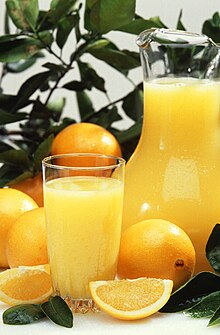Dalandan
| Dalandan | ||||||||||||||||
|---|---|---|---|---|---|---|---|---|---|---|---|---|---|---|---|---|
 Orange blossoms and oranges on tree
| ||||||||||||||||
| Scientific classification | ||||||||||||||||
|
Ing Darangdun, keng English amanu Orange—mismung, sweet orange—dalerayaya keng citrus a pun tanaman Citrus sinensis (syn. Citrus aurantium L. var. dulcis L., o Citrus aurantium Risso) at ing kayang bungang tanaman. Ing dalandan metung yang hybrid ning minunang panaun a mesarul, mapalyaring ding pomelo (Citrus maxima) attangerine (Citrus reticulata). Metung yang malating mamulaklak a pun tanaman daragul mga 10 m a katas a atin emalalagas a bulung, nung nu makaareglu liwasliwas, a ovate a aske a atin crenulate margins at 4-10 cm kaba. Ing dalandan a bungang tanaman metung yang bungang tanaman ning hesperidium, a klasi ning berry.
Ing katayang "orange" ibat ya keng Sanskrit narang o kaya Tamil "naraththai". Deng dalandan ibat la king maulingalbugan ning Asia, king India, o kaya Vietnam o mauling Tsina. Ing bungang tanaman a Citrus sinensis mayayaus yang mayumung dalandan para ikawani ya keng Citrus aurantium, ing mapait a dalandan. Karing aliwang amanu, bantug ya bilang "Isik a manzanas" (e.g. Dutch Sinaasappel (Isik a manzanas)).
Production
[mag-edit | alilan ya ing pikuwanan]| Orange, raw, Florida Nutritional value per 100 g (3.527 oz) | ||||||||||||||||||||||||||||||||||
|---|---|---|---|---|---|---|---|---|---|---|---|---|---|---|---|---|---|---|---|---|---|---|---|---|---|---|---|---|---|---|---|---|---|---|
| Energy 50 kcal 190 kJ | ||||||||||||||||||||||||||||||||||
| ||||||||||||||||||||||||||||||||||
| Percentages are relative to US recommendations for adults. Source: USDA Nutrient database | ||||||||||||||||||||||||||||||||||
Explanation
[alilan ya ing pikuwanan]- Required variables: name, kJ, carbs, fat, protein. Supply units (except for kJ which is in kJ).
- Optional variables: sugars, lactose, satfat, transfat, monofat, polyfat, omega3fat, omega6fat, fiber, fibre, starch, water, alcohol, caffeine. Supply units (normally g).
- Optional freeformat variables (name and value): opt1n, opt1v, etc. up to opt4n and opt4v.
The following optional variables are converted into percentages of RDA (taken as averages for males and females aged 25-50 years from the USDA 2000 recommendation):
- Optional minerals (in mg): calcium_mg, iron_mg, phosphorus_mg, magnesium_mg, sodium_mg, potassium_mg, zinc_mg
- Optional vitamins (in mg, μg, or international units): vitA_ug, thiamin_mg (Vit. B1), riboflavin_mg (Vit. B2), niacin_mg (Vit. B3), pantothenic_mg (pantothenic acid), vitB6_mg, folate_ug, vitB12_ug, vitC_mg, vitD_ug, vitD_iu (in IU), vitE_mg, vitK_ug.
Other optional variables and flags:
- Optional footnote: note
- Optional data source: source, or as a flag: source_usda=1 for the USDA database
- Optional suppression of RDA explanation: noRDA=1
- Optional flags: right=1 (table will be floating on the right)
Further remarks:
- According to convention, there should be a space between the number and the unit: "14 g" and not "14g".
- Splitting up components that are present in trace amounts is not very meaningful (e.g. 1.5 g fats of which 0.5 g unsaturated).
- The author of the template recommendeds to include only vitamins and minerals for which this product is considered to be a major source, in order to prevent clogging up the article with a huge table. As a guideline:
- staple foods: an amount that provides 10,000 kJ should provide well over 100% of the RDI.
- meats and such: same, but for 4,000 kJ.
- vegetables, other low-calorie solid food, fruits: same, but for 400 g.
- other products: use an amount that one could reasonably eat on a daily basis.
Nutritional values can be found e.g. in the USDA National Nutrient Database. Note that fibers are counted as carbohydrates.
Template editing
[alilan ya ing pikuwanan]Don't put linebreaks into the template around the {{#if:...}} parser functions, because they will end up as linebreaks above the table.
Maybe someone can do this in wikitable format rather than raw HTML, if you know how to combine that with the {{#if: }} conditionals. Please experiment in Template:NutritionalvalueTest to prevent breaking article pages.
See also
[alilan ya ing pikuwanan]- {{Nutritional information}}
- {{Nutrition Facts}}
- {{Foodbox}}
</noinclude> According to FAOSTAT, the top producers of oranges (in tonnes) in 2005 were:
| 1. | Brazil | 17,804,600 |
| 2. | USA | 8,393,276 |
| 3. | Mexico | 4,112,711 |
| 4. | India | 3,100,000 |
| 5. | Tsina | 2,412,000 |
| 6. | Espanya | 2,294,600 |
| 7. | Italy | 2,201,025 |
| 8. | Iran | 1,900,000 |
| 9. | Egypt | 1,789,000 |
| 10. | Pakistan | 1,579,900 |

Gallery
[mag-edit | alilan ya ing pikuwanan]-
Litratu ning Cara Cara dalandan (kaili) a atin pink grapefruit para y cumpara king kule at dagul.
-
Ing dalandan atin yang malutu at madalumdum a burgundy katas.
-
'Ambersweet' a dalandan
-
Metung a dalandan a grove.





